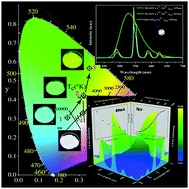Mechanism analysis of a narrow-band ultra-bright green phosphor with its prospect in white light-emitting diodes and field emission displays†
Abstract
In the current study, aiming to get brighter green phosphors for LEDs and FEDs, Ce3+ and Tb3+ were successfully co-doped into the newly discovered matrix, [Mg1.25Si1.25Al2.5]O3N3 through solid-state reaction. The sample presents a broad excitation band covering (n-)UV region from 240 to 420 nm and a sharp green Tb3+ characteristic emission with negligible Ce3+ emission. The efficient energy transfer mechanism from Ce3+ to Tb3+ has been calculated to be dipole–dipole interaction, which leads to a 13% higher brightness at its optimum excitation than the green phosphor of BaSrSiO4:Eu2+ commodity. The gentle thermal quenching trend and relatively high quantum yield of the sample is also remarkable. A LED lamp fabricated by the sample and the commercial phosphors demonstrated better performances than the traditional one with a color rendering index of 84.5 and CIE coordinate of (0.3190, 0.3290). Additionally, the cathodoluminescence spectra of the sample display an outstanding unsaturated peak intensity and anti-degradation as well. The results indicate that [Mg1.25Si1.25Al2.5]O3N3:Ce3+,Tb3+ could be considered as a promising green-emitting material for white LEDs and FEDs application.



 Please wait while we load your content...
Please wait while we load your content...